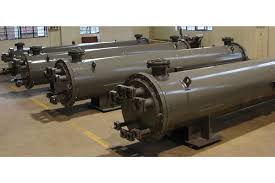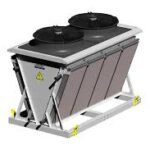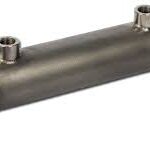Marine Heat Exchangers
Marine Heat Exchangers are essential for cooling engines, generators, and onboard equipment using seawater or freshwater. Made from corrosion-resistant materials like titanium or cupronickel, they ensure durability in harsh marine environments. These heat exchangers maintain optimal operating temperatures and efficiency of marine systems.

Marine Heat Exchangers
Applications of
Marine Heat Exchangers
Types of
- Shell and Tube Heat Exchangers: Commonly used for their robust construction and efficient heat transfer capabilities.
- Plate Heat Exchangers: Compact and lightweight alternatives suitable for space-limited marine applications.
- Coaxial Heat Exchangers: Utilizes concentric tubes for efficient heat exchange, ideal for cooling systems onboard vessels.
- U-Tube Heat Exchangers: Incorporates U-shaped tubes for thermal expansion and contraction, facilitating maintenance and durability.
Marine Heat Exchangers
Characteristics
- Material Selection: Typically constructed from corrosion-resistant materials such as titanium, cupronickel, or stainless steel to withstand seawater exposure.
- Tube Bundle Design: Utilizes tube bundles or plates to facilitate heat exchange between fluids, ensuring efficient thermal performance.
- Seawater Flow: Incorporates seawater pumps or direct seawater circulation to dissipate heat generated by onboard equipment.
- Heat Transfer Mechanism: Implements either tube-and-shell or plate heat exchanger configurations to optimize heat transfer efficiency.
- Compact Footprint: Designed to fit within limited space constraints onboard vessels while maximizing heat transfer surface area.
Other Heat Exchangers We Manufacturer
Dry Cooler
Dry Cooler is a type of heat exchanger that uses ambient air to cool a fluid, typically water or a water-glycol mixture, without evaporating the fluid. It operates on the principle of sensible heat transfer

Stainless Steel Heat Exchanger
Stainless Steel Heat Exchangers are devices that use stainless steel as the primary material for transferring heat between fluids. They are valued for their corrosion resistance, durability in high temperatures and pressures

Copper Heat Exchangers
Copper Heat Exchangers are devices designed to efficiently transfer heat between two fluids or between a fluid and a solid surface. They utilize copper, a highly conductive metal known for its excellent thermal properties.

Boiler Coils
Boiler coils are heat exchangers made of metal tubes arranged in a coil pattern, used in boiler systems to transfer heat from combustion gases to water or steam. They are typically made from heat-resistant materials

Tube in Tube Heat Exchanger
Tube in Tube Heat Exchangers consists of two concentric tubes where one fluid flows through the inner tube and another fluid flows through the annular space between the inner and outer tubes.

